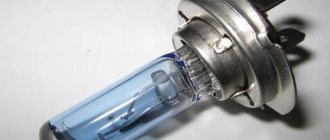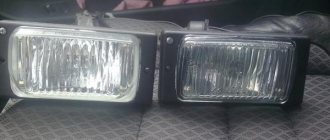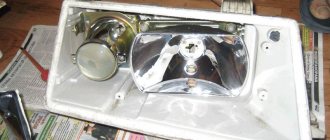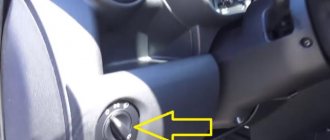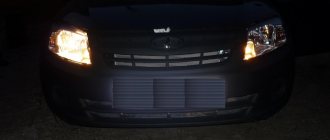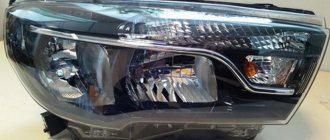Is there a penalty for driving without low beams?
Yes. And there are two of them:
- a fine if your low beam headlights are not on because you forgot or did not want to turn it on,
- the same financial penalty if your lighting fixtures are not in working order.
At the same time, according to the law, a traffic police officer cannot issue 2 orders with 2 sanctions at the same time. Simply because several punishments for one action (or inaction) are not provided for by law (Part 2 of Article 4.4 of the Code of Administrative Offenses of the Russian Federation). And in this case only the more strict one applies.
The only legal application of 2 fines at once for the low beam not working can only be if, for example, your left headlight bulb burned out, but you forgot to turn them on, and therefore the right one was also not working. However, in practice this is unlikely to threaten drivers on Russian roads. The traffic police inspector will simply issue one fine.
During the day or at night?
Please note that a fine for driving without low beam headlights can be issued not only in the dark. Thus, traffic regulations require that you drive with daytime running lights during the day, and if they are missing, then turn on your headlights (below we will discuss in more detail the rules for using lighting devices). In addition, in conditions of poor visibility and in tunnels, the latter is mandatory.
So you are required to use:
- in the daytime (light) time: daytime running lights (DRL) if equipped on your car in general cases, except when driving in poor visibility (in heavy snow, rain or fog with road visibility less than 300 meters) or in a tunnel,
- in the evening/at night (during the dark), as well as in case of insufficient visibility or in a tunnel: low or high beam headlights.
The main rule here is that the neighbor can replace the DRLs during the day, but in the dark there is no reverse possibility - The rules prohibit the use of daytime running lights at night.
DRL chevrolet cruze
The standard Chevrolet Cruze models do not have daytime running lights (DRLs), but there are ways to install them so that they do not clearly stand out from the car’s exterior.
In pre-restyling models before 2011 and cars after restyling from 2012, these are headlight turn signals and fog lamp trims.
New amendments to the traffic rules require driving with low beams or running lights on, even during the day.
In a Chevrolet Cruze, when the low beam is turned on, the dashboard lighting dims, which causes discomfort to many drivers. Therefore, the issue of installing DRLs becomes relevant.
Installing daytime running lights
As already mentioned, the Cruise has 2 places where you can reasonably place DRLs. These are turn signals in headlights and fog lamp covers.
The process of installing daytime running lights, as well as any changes or upgrades in a car's electrical system, requires at least basic knowledge of auto electrics.
Neglecting minor nuances can lead to failure of all vehicle electronics. If you do not have electrical knowledge, it is better to entrust the installation of additional lighting to professionals.
If you decide to install running lights yourself, be sure to turn off the ignition and disconnect the battery before starting work.
Installation in turn signals
This method involves replacing the standard turn signals with 2in1 lamps, which combine DRLs and the turn signals themselves; the lamps are equipped with yellow and white LEDs and turn on alternately.
With this installation method, the DRL lamp will go out when the turn signal is turned on, while the second lamp opposite the turn signal will be on. Since the lamps are LED, after the turn signal is turned off, there will be a slight delay before the running light turns on.
To install lights in the direction indicators of the headlight lamps you need:
- 2 cartridges type BAY15D;
- Two 2in1 lamps (turn signal and DRL) with the above-mentioned socket;
- 4 female connectors and 4 male connectors (2 for each lamp);
- Electrical tape and clamps.
Installation begins by unscrewing the turn signal socket, then remove the electrical tape and cut the wires 1-2 centimeters from the socket, strip them to approximately 1 cm. The socket has 3 wires, 2 plus and 1 minus, the same with the contacts of the lamp itself.
One plus is the DRL, the second turn signal. Therefore, we connect the wires that go to the turn signal to the turn signal (it is better to use some kind of connector for more reliable contact). There is still 1 wire left, these are our daytime running lights, it can be connected to the side lights or fog lights, but in this case the DRL will light up only when the side lights or fog lights are turned on.
You can also run a wire through the cabin to any other power source that produces 12 volts, maybe the ignition (when the ignition is turned on, voltage will be supplied to the DRL), insert a button to the part of the wire that passes through the cabin to turn it on and off as necessary LED running lights. We have analyzed the installation process, but how to implement the inclusion of DRLs is everyone’s choice.
Installing daytime running lights in the bumper
To install the DRL in its original place, you will need to change the fog light cover/plug to a cover with daytime running lights. To replace them it is better to remove the bumper. 2013 models have fog lamp covers of a different shape than earlier models.
You can, of course, do the “collective farm” and dig holes in the plugs, insert lamps there, fill them with silicone or sealant and connect them using the above method, but this is a Chevrolet Cruze, not a classic. Therefore, let's return to the standard method.
The plugs are attached with a bolt to the rear of the bumper, so it will have to be removed anyway. After removing the bumper, unscrew the bolt holding the plugs and disconnect all the clips. After the plugs are removed, insert the daytime lights.
If your configuration includes “empty” wiring, then all that remains is to connect the connectors. If there is none, then you will have to look again for where to plug the minus and where to power the plus. They can be thrown directly to the battery.
The DRLs here also have 3 wires, the remaining wire must be connected to the ACC position ignition, this is where the biggest difficulties arise, since in different Cruise assemblies the ACC wire is either red, sometimes purple with a yellow stripe, sometimes black.
Therefore, you can’t do without calling. The remaining wire does not need to be connected if you connect the daytime lights via a five-pin relay.
Let's consider the connection using the example of relay type 75.377
It is better to place all wiring in a corrugation, or wrap it with electrical tape.
Which headlights to turn on according to traffic regulations?
Depending on the time of day and type of lanterns, the following rules are distinguished.
Headlights not turned on during the day.
At this time, vehicle drivers themselves decide what to turn on: low beam, fog lights or running lights.
Driving at night.
At night, you are supposed to drive with the high beams on (on the highway, but not in the village, not in front of an oncoming driver) or low beams.
It is more convenient to turn on spotlights in the countryside,
in the absence of oncoming cars.
High beam headlights.
When driving on the highway, they cannot be turned on if there is sufficient lighting on the road.
This condition does not apply to rural roads
where there are no street lights.
Fog lights.
There is a fine for keeping rear fog lights on all the time. The front ones should be used if visibility is poor.
If the headlights did not work before the trip or burned out while driving, then this is a different case. According to the traffic rules, article 12.5 part 1 of the Code of Administrative Offenses of the Russian Federation, the driver did not have the right to drive. Especially at night and in bad weather, when cars are almost invisible.
Evidence of wrongdoing
According to the laws of the Russian Federation, traffic police officers must prove their case. A person is not obliged to prove his innocence (until guilt is proven, a person is considered not guilty) - Presumption of innocence, Article 1.5 of the Code of Administrative Offenses.
Traffic police officers must provide visual evidence. Such evidence is photography, video recording, and witness testimony.
If there are no such materials, all unremovable doubts should be interpreted in favor of the person driving the vehicle. As practice shows, traffic police inspectors often break the law when drawing up a protocol, misleading the driver.
It is also not uncommon for an inspector to vaguely explain the situation to witnesses and ask them to sign the protocol as a witness.
The judicial practice of the Russian Federation shows that in most cases, judges side with traffic police officers (there is no reason not to believe the inspector’s words) and do not take into account or ignore the evidence base on the part of the person driving the vehicle (witness testimony, photography, video recording). Penalties for driving with low beams off or one low beam headlight, fog light or daytime running light not working are usually imposed if the car owner is unable to correct the problem on the spot
In order not to prove to traffic police officers and magistrates that you are right, you should check the serviceability of the entire vehicle lighting system before each start of movement. If a person does not agree with the instructor’s accusations, he must write this directly in the protocol.
Penalties for driving with low beams off or one low beam headlight, fog light or daytime running light not working are usually imposed if the car owner is unable to correct the problem on the spot. In order not to prove to traffic police officers and magistrates that you are right, you should check the serviceability of the entire vehicle lighting system before each start of movement. If a person does not agree with the instructor’s accusations, he must write about this directly in the protocol.
In addition to the above violations, there are many others on the road:
- driving on the sidewalk;
- intersection of continuous double markings;
- parking on the lawn;
- unfastened seat belt;
- passage under the “Brick” sign;
- driving through a red traffic light;
- over speed;
- hitting a pedestrian.
Responsibility for violating the rules for using headlights
Keeping the headlights on ensures that the car will be noticed in a timely manner by other road users. This traffic regulation requirement is designed to ensure the safety of drivers on the road, which is especially important at night. It is possible to avoid liability for deviations from the operating regulations of lighting devices only when driving with the lights turned on.
For all other violations, the traffic police officer will punish the driver in accordance with the requirements of the law.
Motorists will receive a fine of 500 rubles in the following circumstances listed below:
- the driver uses only running lights without turning on the low-beam headlights (when driving in low-light conditions);
- the vehicle does not have a lighting device (or operates without meeting the established requirements);
- the motorist uses a car with the lights turned on;
- the owner of the vehicle uses high beam headlights within the city or other populated area, regardless of its size (the main thing is the corresponding road sign notifying the entrance to the NP);
- the motorist uses low-beam headlights during the daytime;
- The vehicle is operated taking into account the incorrect use of fog lighting devices.
Despite the small size of the fine (within 20 days you can pay 50%, which is only 250 rubles), you should not neglect the rules of safe driving. Any violation associated with ignoring the operating rules of lighting devices can lead to an accident on the road.
Is it possible to avoid punishment?
The driver is given two months to pay the fine. The countdown begins from the date when the potential violator is officially notified of the punishment. If the money is not received within the specified period, then the executive authorities have the right to double the amount and impose a forced fine.
The law gives the motorist the right to challenge the imposed sanctions. The law provides a standard period of ten days for this. You can contact a higher authority of the traffic police, the prosecutor's office or the court.
It is difficult to predict the inspector’s actions, but if you can convince him that the incident was accidental, then a fine can be avoided.
This rule does not apply to night trips, since the appearance of a car on the road without lighting makes it invisible to other road users. The only way out here is to call a tow truck. Transporting a car on a sling is also prohibited, since a faulty car will make the person who took it in tow invisible.
Penalty for turning off headlights at night
Driving by car at night or in conditions of poor visibility requires the use of both low and high beams.
It is important to know: if the car does not have daytime running lights, the driver can use low beam headlights. This circumstance can be classified as forced actions. Taking this condition into account, the likelihood of receiving a fine is minimal. Also, when using low beam, the motorist may not take additional measures when driving in the dark.
If the vehicle has working daytime running lights, the driver should take care to turn on the low beam when evening falls. In case of negligent attitude to traffic rules, the owner of the vehicle will receive a warning or a fine of 500 rubles. This penalty is provided for in Article 12.20 of the main administrative document of the country.
Types of punishment
In practice, for the unauthorized installation of additional headlights, 3 types of punishment are possible:
- A fine of 500 rubles for upgrading a car in the form of additional headlights without approval from the traffic police.
- Deprivation of the right to drive a car for a period of 6 months to 1 year for violating the operation of lighting devices.
- Deregistration of a vehicle.
Of the listed penalties, only 2 comply with the law. Let's take a closer look at them.
Deprivation of rights
In this case, this measure would be illegal. The issue is that drivers driving cars with factory-installed halogen headlights that have xenon or LED bulbs are similarly illegally penalized. This is considered a violation of the operating mode of lighting devices.
In a similar way, the court can make a decision with auxiliary headlights, because they are not provided by the factory, and therefore violate the operating mode. Many car owners consider this a contradictory proposition. But the same contradiction can be attributed to xenon, since according to the Technical Regulations the operating mode can be constant or flashing. This does not apply to the type of light source. Therefore, in practice it happens differently.
The Supreme Court of the Russian Federation recently prohibited the deprivation of the rights of drivers who installed xenon under this regulatory act. Therefore, it is hardly possible to apply such a punishment for additional headlights.
Flashing lights
The situation is different if not ordinary headlights are installed, but those that flash. Then the traffic police inspector can file documents against you in court to deprive you of your license. But this issue is controversial, and the court may consider it illegal. Let's figure out what the question is here.
In this case, the law provides for punishment for violating the operating conditions of lighting devices, as well as their color. If you carefully read the text of the sanction, these conditions are also connected by the conjunction “and”. This means that both conditions must be met simultaneously. If additional headlights emit orange, yellow or white light, then this is not prohibited by the Road Traffic Regulations. Only the operating mode is disrupted.
But in this case, the norm of Part 4 of the same Article 12.5 of the Code of Administrative Offenses can also be used. It indicates a possible penalty in the form of deprivation of rights for a period of 1 year to 1 year 6 months. Plus, your additional headlights that are installed on the car may be confiscated. If such headlights are used while driving on the road, your license may be revoked for up to 2 years.
Deregistration of a car
In 2022, this punishment is quite realistic and complies with the law. Many car owners know that if design changes are detected without registration, such a vehicle will be impossible to register with the State Traffic Inspectorate. The inspector will simply refuse you and he will be right.
However, not all drivers know that if a car is already registered with the traffic police, and unregistered additional headlights are found on it, it will be deregistered.
In practice, in real life it goes like this:
- You are driving along the road, a traffic police inspector stops and checks the documents for the car.
- He sees additional lighting devices that are not provided by the manufacturer.
- Checks the registration certificate and finds that the change has not been registered.
- Draws up a resolution imposing a fine of 500 rubles.
- Submits a report to a superior.
- The authorities review the documents and make a decision to deregister the car.
- You will receive a letter by mail about the decision of the traffic police to terminate the registration of the car.
- The issue can only be resolved by removing the additional headlights and presenting the car to a traffic police inspector.
If, after deregistration, you continue to drive your car (even without additional headlights), then when a traffic police inspector stops you on the road, he will take away the registration numbers, STS and put the car in a impound lot. To pick it up, you will have to go through all the procedures again, and also pay for new license plates. Therefore, it is worth thinking before installing illegal lighting devices.
Fine for driving with high beams within populated areas
As you know, in populated areas it is possible to use only low beams. High beams blind and disorient drivers traveling in the opposite direction, resulting in an increased risk of an accident.
It is important to remember in what situations the use of high beam devices is strictly prohibited:
- on sufficiently illuminated sections of the road within cities and other populated areas;
- when passing an oncoming car at a distance of less than 150 meters (the switch to low beam can be carried out earlier if one of the traffic participants asks the other to do so using available signals and signs);
- in other situations in which a motorist may be blinded by the high beams of the lighting devices of an approaching vehicle.
In the vast majority of cases, motorists are brought to justice for this type of offense within the city. When a law enforcement officer stops a violator, the punishment may be limited to a warning, but violators often receive a fine of 500 rubles.
Fine for a non-working headlight
Often, owners of vehicles that are not equipped with a system for auto-checking the performance of vehicle devices overlook the malfunction of the lighting device. It is worth noting that a failed headlight or a burnt-out side light does not constitute a violation in the use of vehicle lighting equipment.
When driving with one headlight on, the driver only violates paragraph 3.3 of the traffic rules, which regulates the list of obstacles to using the vehicle legally until the cause of the violation is eliminated. Thus, operation of the car cannot be resumed until the headlight is restored or the light elements are cleaned (the driver cannot use dirty devices, as this impairs the visibility of the signals).
According to part one of Article 12.5 of the Code of Administrative Offences, punishment for one faulty headlight is a warning or a fine of 500 rubles.
Experimental results
Just recently, driving instructors conducted an experiment that shows the effect of low beams on the reactions of road users. Moreover, safety was put at the forefront.
We studied the Sobol minibus, which was parked on the side of the road at dusk:
- At the first stage, the car was installed on a country road with good visibility. At first it was viewed from a distance of 300 meters. The car was visible well.
- Then the distance was increased to one kilometer. A minibus without external light illumination disappears altogether. After the appearance of low beam, the situation changes dramatically. Thus, illuminated headlights improve the visibility of the car.
- Afterwards the experiment was continued on the forest road. Here, even from 200 meters, a vehicle is almost impossible to notice. When the low beam is on, the minibus is clearly visible even from a greater distance.
Experiments have shown that an unlit car becomes almost invisible on the road at dusk. Turning on the headlights increases the visibility of the car both on a cloudy and even on a sunny day.
Low beam substitute
According to road rules, you can drive with fog lights without low beams (clauses 19.4, 19.5 of the traffic rules). You can also use daytime running lights.
It will not be a violation if you turn on the low beam in combination with fog lights and running lights.
But you should know that in some cars the head fog lights are turned on in the same mode as the rear fog lights. This would already be a violation. After all, the rear ones are used only in unclear weather.
Is it possible or not?
Now we are gradually approaching the answer to the main question.
Motorists are afraid of getting a fine, but at the same time they want to improve visibility conditions by driving their own car. What's the best way to proceed?
Here you should understand what is called front or head optics.
It is indeed prohibited to install yellow lamps in high or low beam according to the rules prescribed in the traffic rules, as well as in the technical regulations. If you look at the Technical Regulations, there is Appendix 7, clause 3.1. It clearly states that the use of yellow light bulbs in the country is permitted only as part of anti-fog optics. And as you know, fog lights are installed front and rear. That is, it is allowed to install such lamps in the front of the car. Only if it is not high beam or low beam.
Everything is quite clear here.
By the way, the idea of installing a color protective film should also be abandoned. By giving the main headlights a yellowish tint, you will most likely be stopped and fined for technical non-compliance.
If you look at the Code of Administrative Offenses related to traffic rules, paragraph 3.6 states that the use of yellow, orange and white spectrum lamps is allowed in the front part. Here it is also allowed to use yellow lights on the rear optics.
How is a violation recorded?
The issue of imposing a fine for not turning on the low beams is dealt with by traffic police officers from the moment the violation is detected until the punishment is imposed.
As a rule, after identifying a violation on the spot, a resolution on administrative liability is drawn up.
Not in all cases you should agree with the traffic police officer.
You can prove a traffic violation for low beam headlights during the day if:
- there are witnesses to the offense;
- driving recorded on video;
- The driver himself admits his guilt.
Therefore, if no evidence is presented, the driver can safely defend his truth. Such materials are easily challenged in court.
If the fact of a violation is undeniable, one should strive to reduce everything to a warning. That is, do not conflict, talk about driving without a penalty, remind about the possibility of warning, etc.
How can you prove it?
Everything is very simple. There are 2 possible “proofs”.
Official publication of changes
Since the traffic rules are formally a by-law approved by a decree of the Russian Government, changes are introduced by the relevant resolutions. And it’s easy to prove that there were no changes regarding lighting devices, knowing how the regulations come into force:
- the resolution is introduced for discussion and adopted,
- further, the published change must be published on one of the official websites of legal information, and these are regulated by Presidential Decree No. 763 of May 23, 1996 on the procedure for the entry into force of legislative acts.
Paragraph 2 of this Decree tells us the following:
Accordingly, by going to these sites we will not find any official resolutions on changing the rules for driving during the day without low beam headlights from April 1, 2022:
- not on the Rossiyskaya Gazeta website,
- nor on the legal information website.
Why are headlights needed during the day?
There are several reasons why you should turn on a lighting fixture:
- Often a traffic police officer stops a driver because the lights are out. And, in addition to a fine for driving without headlights, this becomes a reason to look for other violations;
- Of course, this is a security issue. Both the other driver and the pedestrian see you. This will avoid many troubles on the road;
- When the lights are on, the instrument panel in the cabin also lights up. Such information is important for the motorist.
How to choose daytime running lights
The reason for this is the reduced electricity consumption of such lamps. This is noticed by a monitoring relay, which constantly monitors the normal operation of the lamps. So, seeing a reduced current supply, the driver will be shown a corresponding message that the lamp has become unusable. The indicator will be constantly lit on the instrument panel, or the on-board system will sound an audible alarm. However, the sound signal will only be heard in a situation where the instrument panel is replaced with a similar one, but of a European version.
Bright, but not legal!
In addition, if you replace a yellow LED without chromaticity with a white one, it can additionally include various shades, ranging from blue to purple.
Cancel the use of low beam
Recently, changes have often been made to traffic rules, so many drivers have a question: do they need to turn on headlights during the day in the city from 2022?
Indeed, the traffic rules have undergone a number of changes, but this did not affect the procedure for using lighting devices. Therefore, all this is from the category of rumors and assumptions.
So far there are no prerequisites for this. The obligation to use headlights during the day has existed for 8 years. And this has only a positive effect.
Perhaps this need will be canceled. To do this, an official document will be published that will contain information from what date you can not turn on the low beam.
What's the truth?
They were allowed to drive during the day without headlights - this is the truth. But not in Russia. The corresponding decree was issued by the authorities of Transnistria, an unrecognized state of the Moldavian Republic... 2 years ago
How this news suddenly spread to Russian traffic regulations remains a mystery. But the fact remains - in Transnistria, indeed, from April 1 to September 30, you can not turn on low beam headlights during the day (video about this below), but Russian traffic rules in this regard have not changed.
Revisions of traffic regulations
But most importantly, none of them has in the list of changes section 19 of the traffic rules, which specifically concerns lighting devices.
- the edition, which came into force on March 18, made reflective vests mandatory,
- the second will take effect on April 28 and marks the appearance of waffle markings at intersections,
- the third – from July 1 and will regulate the environmental class of cars.
As you can see, no changes have been introduced to the traffic rules since April 1, 2022, and you still need to turn on your headlights during the day.
What to do if the headlight suddenly stops working
Recommended actions:
- calling a tow truck;
- towing by other vehicles;
- waiting for daylight.
During the day, the Rules allow you to reach a service station or parking lot with unlit lighting equipment.
If none of the proposed options is suitable, the motorist proceeds in the following sequence:
- Turns on the hazard warning lights and stops the vehicle on the side of the road.
- Checks the functionality of the DRL, PF and side lights.
- If the lights are working properly, it lights up all available ones and starts driving at low speed in the right lane. If the lights are not working, the car must be removed from the roadway (clause 19.4), and if this is not possible, it must be marked with a warning triangle or a flashing red light (clause 9.11).
If all on-board lighting turns out to be inoperative, take the following measures:
- attach to the bumper using improvised means or hold a flashlight in your hands;
- install a warning triangle with reflectors on the shelf near the rear window.
After this, they begin to move at low speed. It is advisable to line up behind another slowly moving vehicle - a truck, for example. This solution will help avoid a collision with an oncoming car.
In order not to be left at night without light, you should read the instructions regarding replacing relays and lamps, and also have several spare parts with you.
Rules for using standard running lights
The design of many modern cars provides for the presence of daytime (standard) running lights.
The law allows their use during the daytime instead of low-beam headlamps.
But independent installation of such lighting equipment without obtaining the appropriate permission and registration is prohibited. This is considered as unauthorized modification to the vehicle.
Punishable by a fine and an order to dismantle the installed equipment. But if the installation of DRLs is carried out in accordance with GOST R 41.48-2004, and the appropriate certificates and permits are available, then the operation of such a vehicle is permitted by law.
Important! Owners of cars with factory-installed DRLs do not have to worry about turning on this device in a timely manner. The design of such vehicles provides for automatic ignition of daytime running lights when the engine is started. According to GOST requirements, self-installed equipment should also operate
To ensure that DRLs function correctly, it is best to entrust their installation to maintenance specialists
According to GOST requirements, self-installed equipment should also operate in the same way. To ensure that DRLs function correctly, it is best to entrust their installation to maintenance specialists.
Only a specialist can guarantee that the installation of the device complies with regulatory requirements.
Controversial situations and ways to resolve them
Although the amount of the fine by modern standards is not so large, if the driver is right, it is worth trying to prove it, at least as a matter of principle. Especially if the inspector simply begins to “put pressure” on the driver without any particular reason.
To begin with, when the inspector discovers a malfunction of the headlight (as, indeed, any similar one), it is worth politely informing that the movement was in the direction of the technical station. service or parking to correct this problem. Or simply pretend that the headlight burned out just about during the trip, but when it started it was properly performing its function. In this case, the driver can only get away with a verbal warning.
But it is worth remembering that with one working headlight you can only go to the place where the problem is corrected.
Cameras have learned to detect turned off headlights - is this true?
Yes. Just as cars themselves have long been able to see the lights on oncoming cars, which is used in systems for automatically switching headlights from high to low and vice versa, cameras for automatically recording violations are also able to see the beam of light emitted from the car. In addition, video and photo recording tools have already taught us to determine where the headlights themselves are located on the car.
However, just recently one of the developers and installers of fixation devices reported that it was their cameras that had learned to recognize when the lights were off.
However, all this becomes important for us as car enthusiasts from the point of view of specific financial risks.
Light and sound devices of the car and their location
We should start with the basics, or rather with what types of headlights and lanterns modern cars are equipped with.
- Low beam headlights - designed to illuminate the road and surrounding area in a relatively small area.
- High beam headlights are powerful lighting devices that illuminate the roadway over a fairly large area. Due to its high brightness, high beams can blind oncoming drivers.
- Front fog lights - installed lower than conventional headlights, create a wide beam of light that well illuminates the road and the surrounding area in conditions of fog, snowfall and rain.
- Daytime running lights are a separate type of headlights that are turned on during the day, regardless of weather or visibility, and are designed to increase the visibility of vehicles. Most models turn on immediately when the engine starts.
- Tail lights - designed to identify the vehicle at night or in poor visibility conditions. The color of the lamps is red.
- Brake lights are red lights that come on when a vehicle slows down. They burn much brighter than the side lights. Some cars are additionally equipped with a central brake light.
- Rear fog lights - indicate the vehicle in fog, rain or snowstorm conditions. Not to be confused with brake lights.
- Reversing lights are white and are designed to inform pedestrians and other motorists that the vehicle will be moving (or is already moving) in reverse.
- Rear reflectors - used for the same purpose as side lights, they reflect the light falling on them from the headlights of passing cars. May also be known as retroreflectors.
- License plate lighting – several white bulbs designed to illuminate the rear license plate of a vehicle.
- Turn signals, or “turn signals,” are amber lights that are used to inform you that the vehicle is turning or otherwise maneuvering. Installed in the corners and on the sides of the car.
This is interesting: How many liters of oil are in a Ford Focus 2 engine
But do the traffic police issue a fine for leaving the lights on now?
No. Despite the fact that you will find the most contradictory information about this latest news on the Internet, cameras that automatically record traffic violations as of December 7, 2022 do not send “chain letters” specifically for not turning on headlights, either day or night.
However, many publications on the Internet are disseminating information that such a system will be operational in the near future. However, this information was officially denied by the Russian Ministry of Internal Affairs.
Thus, today, auto-fixing systems do not issue traffic police fines for turning off the low beam headlights.
Moreover, this works for both times of day:
- cameras do not issue fines for not turning on headlights (or DRLs) as in the daytime,
- just as there is no automatic punishment for a more serious violation - turning off the lights at night.
Updated 08/10/2021. Meanwhile, a number of publications report that in practice, since July, active issuance of decisions has been carried out using automatic means of recording such a violation as not turning on low beam headlights. Moreover, for now such cameras only work in Nizhny Novgorod.
Changing something good only spoils it
“Now the old rules continue to apply; no new amendments to the traffic rules regarding lighting devices have been adopted,” says Pyotr Shkumatov. But there is one point hidden in the traffic rules, around which the controversy began.
The fact is that the latest amendments to paragraph 19.5 of the traffic rules were approved in 2010. They have significantly tightened the rules for the use of lighting devices on vehicles. If previously passenger cars were required to drive during the day with lights only outside the city, then in the new edition of the traffic rules this has become mandatory within populated areas. Meanwhile, 8 years ago there was some relaxation. It was allowed to use daytime running lights instead of low beam headlights. The literally edited clause 19.5 of the traffic rules read: “During daylight hours, low-beam headlights or daytime running lights must be turned on on all moving vehicles for the purpose of identifying them.”
Apparently, the addition “or daytime running lights” has caused so many discrepancies and interpretations. Some drivers thought that instead of bright low beams during the day, they could limit themselves to dim headlights. What does this lead to?
Is it possible to cut a turn through a solid road and how to avoid deprivation of rights? More details
This is interesting: What is the density of gasoline
When will they start?
This is not yet known. The developers of the complex themselves presented that 1.5 thousand new cameras will soon appear that can recognize this violation of the Traffic Rules:
- supposedly 600 of them will be installed in Moscow,
- and another 900 in large cities and regional capitals.
However, cameras do not currently detect headlights being turned off. The question of when they will start doing this remains open. But, most likely, not in the near future, since the system still needs to be tested for erroneously detected violations.
For comparison, the issue of identifying the absence of compulsory motor insurance from video recording cameras has been open for several years. Moreover, there were also official statements that the system would soon start working. But “the problem is still there” - in automatic mode, driving without insurance will not be detected in 2021.
Hazard lights: what they are for and when to turn them on
The so-called “emergency light” is also a combination of the operation of several lighting devices, and therefore belongs to the section in the traffic regulations that regulates the use of various modes of operation of car headlights. What should you consider when activating the emergency alarm mode?
The very first thing is, of course, emergency situations in which not only emergency lights are involved, but also an emergency stop sign. The latter must always be in your trunk, otherwise you will violate traffic rules. Regardless of where the emergency breakdown of your car occurred, in a vacant lot or on the highway, you need to protect yourself and other road users by marking your car in accordance with the traffic rules. A warning triangle is installed on the route to your car 15 or 30 meters from it, depending on the location of the breakdown.
